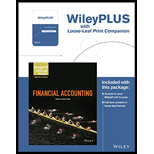
Concept explainers
(a)
Liquidity ratio measures the short-term capacity of a company to pay its maturing obligations, and to meet unanticipated requirements for cash. Liquidity ratios are
Solvency ratio
Solvency ratio measures the capacity of a company to sustain over a long period of time. Solvency ratios are debt to assets ratio, time interest earned ratio, and debt to equity ratio, and more.
To Compute: The current ratio and working capital of Company G for the year 2019.
(b)
To Compute: The current ratio and working capital of Company G, if the company used $3,000 cash to pay off $3,000 of accounts payable for the year 2019.
(c)
To Compute: The debt to assets ratio using total liabilities and total assets of Company G for the year 2019.
To Compute: The times interest earned ratio using earnings before interest, and taxes and interest expenses for the year 2019.
Want to see the full answer?
Check out a sample textbook solution
Chapter 10 Solutions
Financial Accounting, 10e WileyPLUS Registration Card + Loose-leaf Print Companion
- How much it charge per unit?arrow_forwardI am trying to find the accurate solution to this financial accounting problem with appropriate explanations.arrow_forwardOasis Corporation has a new common stock issue that paid a $2.10dividend last year. The par value of the stock is $20, and the firm's dividends per share have grown at a rate of 6.5% per year. The growth rate is expected to continue in the foreseeable future. The price of this stock is now $32.80. The cost of common equity for the firm is __%.arrow_forward
- Can you explain the correct approach to solve this general accounting question?arrow_forwardA firm has an asset with a market value of $10,000 and a book value of $4,000. If its marginal tax rate is 25%, what will the net proceeds from selling the asset be?Solve thisarrow_forwardPlease explain the solution to this financial accounting problem with accurate explanations.arrow_forward
- I need help with this financial accounting problem using proper accounting guidelines.arrow_forwardInventory: Omega Enterprises has an annual demand for units of inventory of 1,500 per year. The cost of placing an order each time is $75, and each item of inventory costs $3 to store. In this case, what would be the optimal amount of stock that should be ordered?arrow_forward5 PTSarrow_forward

 AccountingAccountingISBN:9781337272094Author:WARREN, Carl S., Reeve, James M., Duchac, Jonathan E.Publisher:Cengage Learning,
AccountingAccountingISBN:9781337272094Author:WARREN, Carl S., Reeve, James M., Duchac, Jonathan E.Publisher:Cengage Learning, Accounting Information SystemsAccountingISBN:9781337619202Author:Hall, James A.Publisher:Cengage Learning,
Accounting Information SystemsAccountingISBN:9781337619202Author:Hall, James A.Publisher:Cengage Learning, Horngren's Cost Accounting: A Managerial Emphasis...AccountingISBN:9780134475585Author:Srikant M. Datar, Madhav V. RajanPublisher:PEARSON
Horngren's Cost Accounting: A Managerial Emphasis...AccountingISBN:9780134475585Author:Srikant M. Datar, Madhav V. RajanPublisher:PEARSON Intermediate AccountingAccountingISBN:9781259722660Author:J. David Spiceland, Mark W. Nelson, Wayne M ThomasPublisher:McGraw-Hill Education
Intermediate AccountingAccountingISBN:9781259722660Author:J. David Spiceland, Mark W. Nelson, Wayne M ThomasPublisher:McGraw-Hill Education Financial and Managerial AccountingAccountingISBN:9781259726705Author:John J Wild, Ken W. Shaw, Barbara Chiappetta Fundamental Accounting PrinciplesPublisher:McGraw-Hill Education
Financial and Managerial AccountingAccountingISBN:9781259726705Author:John J Wild, Ken W. Shaw, Barbara Chiappetta Fundamental Accounting PrinciplesPublisher:McGraw-Hill Education





